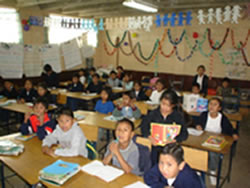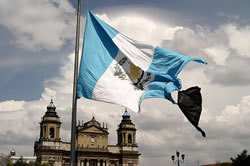| Home > Guatemala |
GUATEMALA:
Country Profile of Guatemala
Guatemala is a democratic republic in Central America. It is bordered by Mexico to the north and west, the Pacific Ocean to the southwest, Belize to the northeast, the Caribbean to the east, and Honduras and El Salvador to the southeast. Guatemala is a popular tourist destination which boasts a rich history and impressive landscape.
|
☻Capital: - Guatemala City ☻Area: - Total: 108,890 km2 (106th) 42,042 sq mi - Water (%): 0.4 ☻Independence: From Spain -15 September 1821 |
☻Official languages: - Spanish ☻Population: - July 2006 estimate:13,000,000(70th) - July 1007 census: 12,728,111 - Density: 134.6/km2 (85th) 348.6/sq mi |
Geography of Guatemala:
 Guatemala is the most western of the Central American states.
Guatemala is the most western of the Central American states. The country is mainly mountainous, which served as a great advantage for the indigenous peoples seeking refuge during the Spanish conquest in the 16th century.
Two mountain chains divide Guatemala from west to east into three major regions: the western highlands, where the mountains are located; the Pacific coast, south of the mountains; and the Petén region, north of the mountains.
These areas vary in climate, altitude, and landscape, providing striking contrasts between dense tropical lowlands and highland peaks and valleys. Natural disasters have an extensive history in the geography of Guatemala.
The highlands lie on a fault which has been responsible for several major earthquakes in historic times and several of the volcanoes are active, including Tajumulco (4220 m/13,845 ft), in the Sierra Madre mountain range, which is also the highest point in the country.
Education in Guatemala:
 Guatemala’s education system is facing a lot of problems in all sectors.
Guatemala’s education system is facing a lot of problems in all sectors. Nursery schools, primary schools, secondary schools and universities all suffer in the hands of the state from extreme lack of money and insufficient and poorly-equipped classrooms.
Teachers are often ill-qualified and paid either a very small or no salary. Although the situationis far better in private schools, only the middle and upper classes, which make up a tinypart of the population, have the money to attend. Another problem is that many indigenous parents do not see the point in educating their children, because the curriculum does not teach the Mayan language or its culture and history. For this reason, they often do not take them to school, especially during harvest, which inevitably leads to high drop-out rates and low figures in primary qualifications. In order for the situation to improve, urgent progression needs to be made in the professional training of teachers.
Health in Guatemala:
Guatemala's health care system consists of three sectors: public, private non-profit and private for-profit. Medical facilities are generally poor, with over 40% of the population receiving no access to health care services. State-run hospitals tend to be under-funded and can be unhygienic. Malaria rates are high as the disease is prevalent in the low-lying areas outside Guatemala City and dengue fever is widespread. Guatemala is also considered to have a concentrated epidemic of aids and accounts for nearly one-sixth of Central America’s HIV-infected population. Guatemala does try to vaccinate its children and the government pays for all routine vaccinations. Yet unfortunately many still live in poverty and suffer from psychological problems and malnutrition.
Politics in Guatemala:
 As a presidential representative democratic republic, the President of Guatemala is head of state, of government, and of a multi-party system. The country’s 22 departments are governed by a 3-branch structure. Executive power is implemented by the government. Legislative power is held by both the government and the Congress of the Republic. The judiciary, headed by the Supreme Court of Justice, is independent of the executive and the legislature. The terms of office for president, vice president, and congressional deputies are four years, as for mayors and city councils, while it is five for Supreme Court justice. Political parties in Guatemala are by and large numerous and unstable. No party has won the presidency more than once and in every election period the majority of the parties are undersized and newly-formed. The 2 main political parties active in Guatemala today are the Guatemalan Republican Front (FGR), to which current President Alfonso Portillo belongs, and the National Advancement Party (PAN), to which his predecessor Alvaro Arzú belonged. Both parties are conservative and maintain scrupulous economic programs involving fiscal discipline and macroeconomic stability, but Portillo and the FRG also sustain policies designed to help the poorer classes. However, the Congress has not supported Portillo’s policies and as a result, little has been done to improve the situation of finally disadvantaged Guatemalans since he took office in early 2000.
As a presidential representative democratic republic, the President of Guatemala is head of state, of government, and of a multi-party system. The country’s 22 departments are governed by a 3-branch structure. Executive power is implemented by the government. Legislative power is held by both the government and the Congress of the Republic. The judiciary, headed by the Supreme Court of Justice, is independent of the executive and the legislature. The terms of office for president, vice president, and congressional deputies are four years, as for mayors and city councils, while it is five for Supreme Court justice. Political parties in Guatemala are by and large numerous and unstable. No party has won the presidency more than once and in every election period the majority of the parties are undersized and newly-formed. The 2 main political parties active in Guatemala today are the Guatemalan Republican Front (FGR), to which current President Alfonso Portillo belongs, and the National Advancement Party (PAN), to which his predecessor Alvaro Arzú belonged. Both parties are conservative and maintain scrupulous economic programs involving fiscal discipline and macroeconomic stability, but Portillo and the FRG also sustain policies designed to help the poorer classes. However, the Congress has not supported Portillo’s policies and as a result, little has been done to improve the situation of finally disadvantaged Guatemalans since he took office in early 2000.